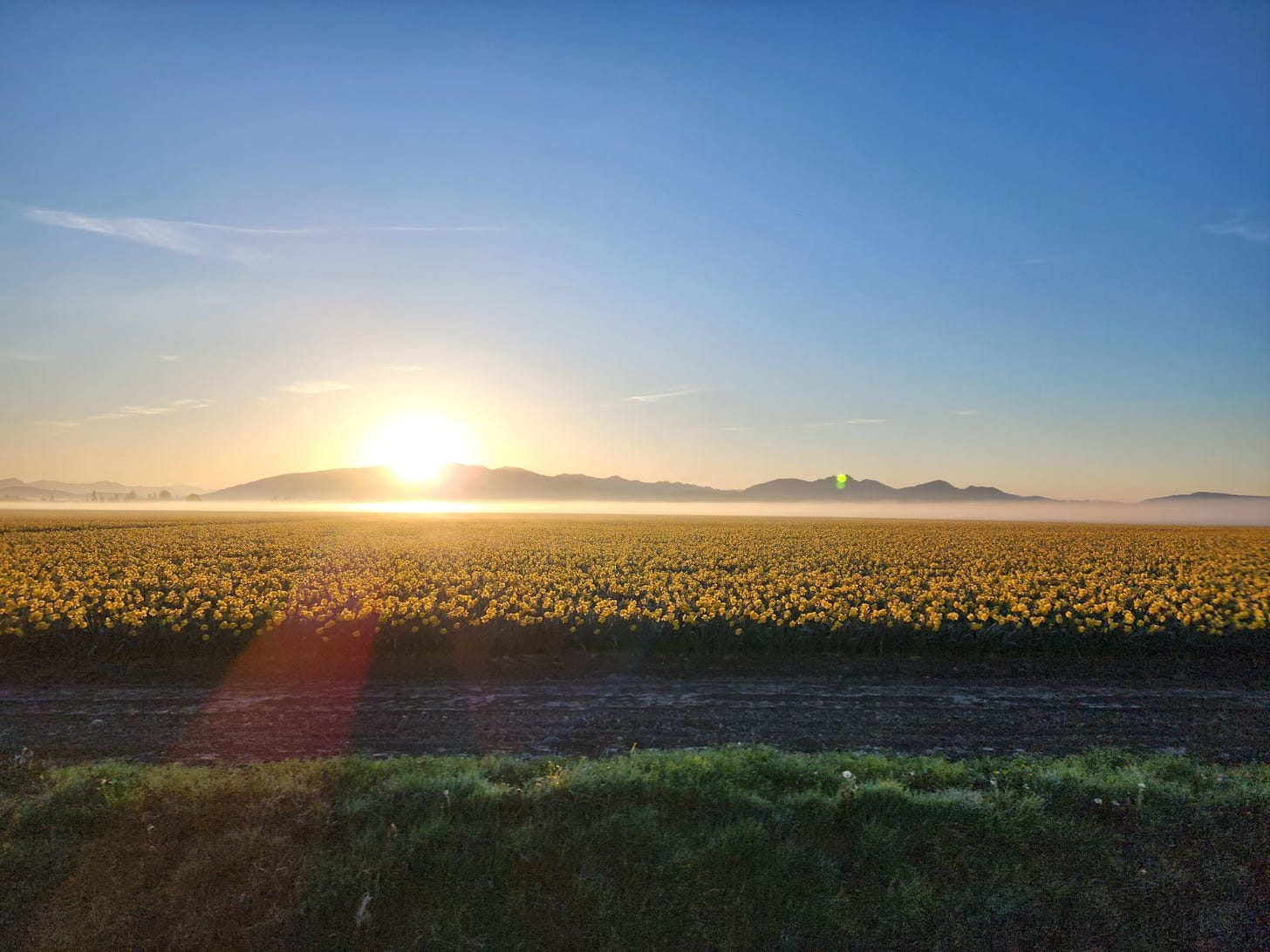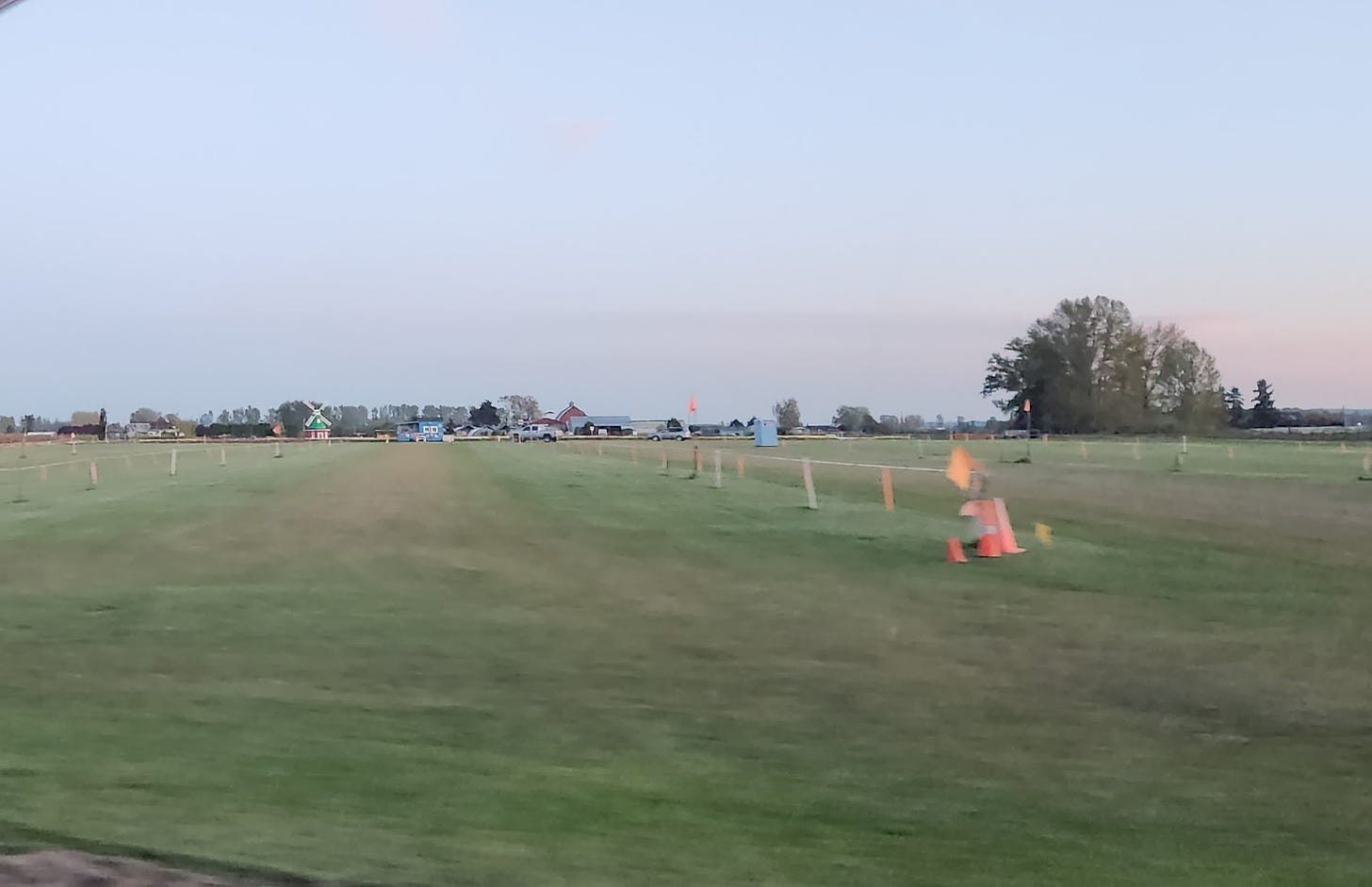When friends wanted to know where we were moving two years ago, I simply told them to search for “Skagit Valley” images online. “You’ll see lots of tulips,” I told them. (Try it!) Although the Skagit area contains much more, tulips give it some renown. During April, acres and acres of colorful tulips and elaborately designed gardens attract thousands of visitors. As someone who lives here, and as someone who avoids crowds when possible, I participate in the Skagit Valley Tulip Festival at a distance most of the time.
But The Field Trip is meant to get me out and to pay close attention, so this time around, I tiptoed to the tulips at dawn and at dusk last weekend to see what I’d discover about this place. Read on!
At Dusk, At Dawn
Last weekend here felt like spring, sunny and in the vicinity of warm. The valley’s colors are showing a wider range of shades as deciduous trees are growing leaves, farmers are plowing their fields, and yards are sprouting flowers. Just before sunset, I headed toward the tulip fields, a leisurely 20-minute drive.
The low sun lengthened the shadows. The old church I can see from my office gathered the light through its western wall of windows, illuminating the sanctuary as if lit by a thousand lights. The Olympics to the southwest were draped in a faded purple hue. The fields the straight-arrow road cut through mostly are not planted yet, but one farmer was crossing a field, tractor lights on, turning the soil.
The scene, so different from where I’ve spent my adult life, now feels like home.
Except the eastbound lane was stacked solid with cars, many of them EVs, heading back south to Seattle and its suburbs, their day in the valley done.

The next morning, I repeated the trip just after sunrise. The light was just as interesting from the opposite side of the sky. The sun peeked over the foothills where I live, spotlighting the valley floor. But that ground seemed submerged beneath light fog, giving the fields a misty feel.
Two Approaches
As I got nearer to the tulip fields, I began noticing two approaches residents took to adapting to the much-increased traffic on their roads.
One type was entrepreneurial. A farmstand sold tomato starts. A driveway was set up for a gem sale. A sign announced “Bathroom $2.00,” a Honey Bucket sitting off to the side.
One type was standoffish. Cones blocked driveways. A chain hung in the way. Private Property / No Trespassing / No Turnaround signs were prominent. Even a street sign I had not noticed before—Local Traffic Only—helped dissuade drivers from exploring some local roads.
I am not deep enough into the community after these two years to pretend I understand residents’ feelings, but this dual approach seemed to reflect common approaches not just to the tulip festival but tourist activities more broadly.
Comparison
A historian I knew a little, Hal Rothman, published an important book about tourism in the American West; he called it Devil’s Bargains. Let me simplify Rothman’s argument.
In many communities, some part of the local population identified tourism as a promising avenue for economic development. This had always been true, but it became increasingly so after many resource-based communities lost ground when they depleted their minerals or forests and as environmental values that preferred intact ecosystems increased. As tourism developed, the special local culture that made a community an attractive place lost its essence—and often pushed locals out, no longer able to afford the higher costs.
This was the devil’s bargain: economic growth exchanged for the loss of particular culture and affordability.
Santa Fe or Bozeman is not a perfect comparison to the Skagit Valley and the $2 port-a-potty. But there are things worth pondering.
A place that offers something beautiful or interesting to others attracts money and people from elsewhere. The presence of that input shifts how locals live, even while the economic boost helps.
It can be tempting to erect metaphoric walls, but that’s typically unrealistic.
Besides, pride of place often wins out. When you live somewhere special, you want to share it, even when it inconveniences you.
Sharing Place
Along one road, both at dusk and dawn, cars pulled to one side bumper to bumper to bumper. There was room, barely. On the other side, next to many No Parking Any Time signs, a hulking SUV parked. I’ll admit I felt some irritation, minor compared to what I know farmers feel when they have to navigate these roads with their tractors and equipment.
But it is hard to resist the spectacle of the tulips. Photographers set up their tripods. Couples wrapped their arms around each other. Someone sold fresh-cut tulips. The sun pushed the shadows away.
Closing Words
Relevant Reruns
This old newsletter recounts a trip I took to the local history museum, a fitting rerun for this week. I’ve done a couple tulip-related stories. This one covered a friend who photographed this year’s official festival poster. This one (which I also shared last week) featured a local garden.
New Writing
My latest reported piece is out with Salish Current. It tells the story of a local flour mill and wheat farmers. It’s a fascinating dynamic that is being carefully built to strengthen agriculture here.
And don’t miss the interview with writer Debbie Lee that I shared with paid subscribers on Monday. (Maybe now is a good time for you to upgrade your subscription?)
I’m giving a public lecture on Saturday in St. Paul based on my last book, Making America’s Public Lands. There is an option to watch virtually. Details here.
As always, you can find my books, and books where some of my work is included, at my Bookshop affiliate page (where, if you order, I get a small benefit).
Taking Bearings Next Week
I am traveling to Minnesota today. In fact, I’m likely on an airplane when this drops in your inbox. Perhaps the flights will give me ample time to read something new, because The Library is up next week.






The only difference between PNW and California is the environmental rape and pillage is more easily observed. The real issue in the American west the theft of 90% of the peoples water for agribusiness corporate subsidy facilitation. We should replace that model, not only there but everywhere, with an agricultural one.
Most people don’t understand the difference between agribusiness and agriculture. They are entirely and diametrically opposed paradigms.
The practicing of agriculture produces food, conserve and improve the soil, receiving a fair price to do so.
Participants in the agribusiness model or not Farmer’s. They are miners by definition. Using more calories than you produce makes it so. They produce commodities which are toxic from input to product, degrading the environment and poisoning our air water soil and bodies as they do it.
Might touch on that someday……..🤷♂️
Nicely written!